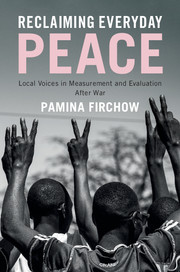Book contents
- Reclaiming Everyday Peace
- Reclaiming Everyday Peace
- Copyright page
- Dedication
- Contents
- Figures
- Tables
- Acknowledgments
- Abbreviations
- Introduction
- Part I Understanding Everyday Peace
- 1 Measuring Peace
- 2 Who Counts in the Measurement of Peace?
- 3 A New Approach to Measuring Peace
- Part II Evaluating Everyday Peace
- Conclusion
- Book part
- Bibliography
- Index
2 - Who Counts in the Measurement of Peace?
from Part I - Understanding Everyday Peace
Published online by Cambridge University Press: 21 September 2018
- Reclaiming Everyday Peace
- Reclaiming Everyday Peace
- Copyright page
- Dedication
- Contents
- Figures
- Tables
- Acknowledgments
- Abbreviations
- Introduction
- Part I Understanding Everyday Peace
- 1 Measuring Peace
- 2 Who Counts in the Measurement of Peace?
- 3 A New Approach to Measuring Peace
- Part II Evaluating Everyday Peace
- Conclusion
- Book part
- Bibliography
- Index
Summary
- Type
- Chapter
- Information
- Reclaiming Everyday PeaceLocal Voices in Measurement and Evaluation After War, pp. 54 - 67Publisher: Cambridge University PressPrint publication year: 2018

